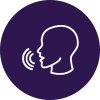Services
Speech Therapy
Speech therapy is provided to children who have difficulty with communication and related disorders, from auditory and memory to voice and oral-motor. Disorders may range from simple sound repetitions and misarticulations to the complete inability to communicate through the use of speech and language.
A receptive language disorder is diagnosed when an individual does not demonstrate the ability to comprehend age-appropropriate vocabulary, follow instructions or understand foundational communication skills such as turn-taking and perspective-taking during conversation.
An expressive language disorder is characterized by a child having difficulty expressing himself using speech. He may have problems putting sentences together coherently, using proper grammar, recalling the appropriate word to use, etc. A child with expressive language disorder is not able to communicate thoughts, needs, or wants at the same level or with the same complexity his or her peers. The child often has a smaller vocabulary than his or her peers.
Social (pragmatic) communication disorder is characterized by difficulty with the use of social language and communication skills. A child or teen with this disorder will have difficulty following the ordinary social rules of communication, following the rules for storytelling or conversations, and changing language depending upon the situation or needs of the listener.
An articulation disorder is characterized by a child having trouble physically producing a sound or sounds, and phonological processing disorders, in which the child produces set patterns of sound errors. Children who have phonological processing disorders have not learned the rules for how sounds fit together to make words, and use certain processes to simplify words.
Oral motor therapy works on the oral skills necessary for proper speech development. These skills include: awareness, strength, coordination, movement, and endurance of the lips, cheeks, tongue, and jaw. We look at normal and abnormal patterns of the lips, tongue, jaw, cheeks, hard palate and soft palate for eating, drinking, facial expression and speech to determine which functional skills a client has to build on, and which abnormal patterns need to be inhibited or for which compensation is needed.
Fluency is the aspect of speech production that refers to continuity, smoothness, rate, and effort. Stuttering, the most common fluency disorder, is an interruption in the flow of speaking characterized by repetitions, sound prolongations, blocks, interjections, and revisions, which may affect the rate and rhythm of speech. These disfluencies may be accompanied by physical tension, negative reactions, secondary behaviors, and avoidance of sounds, words, or speaking situations.
A voice disorder occurs when the vocal cords do not produce a clear sound. Sometimes these conditions are referred to as disorders of the larynx or voice box disorders.
Occupational Therapy
Occupational Therapy focuses on helping children develop the skills they need to grow into functional, independent adults. This can involve games, puzzles, toys, songs and physical exercises. Through working with Pediatric Occupational Therapists, children are not only enabled to develop critical skills, but they often also build upon their levels of confidence and self-esteem.
The development of a child's handwriting can provide clues to developmental problems that could hinder a child's learning because teachers depend on written work to measure how well a child is learning. Occupational therapists can evaluate the underlying components that support a student's handwriting, such as muscle strength, endurance, coordination, and motor control, and parents can encourage activities at home to support good handwriting skills.
Self-regulation is a child’s ability to adjust and control their energy level, emotions, behaviors and attention. Appropriate self-regulation suggests that this adjustment and control is conducted in ways that are socially acceptable.
Sensory integration therapy aims to help kids with sensory processing concerns by exposing them to sensory stimulation in a structured, repetitive way. The theory behind it is that over time, the brain will adapt and allow kids to process and react to sensations more efficiently.
Fine-motor coordination involves the ability to control the small muscles of the body and is usually defined as the ability to coordinate the action of the eyes and hands together in performing precise manipulative movements (eye-hand coordination).
Gross motor (physical) skills are those which require whole body movement and which involve the large (core stabilising) muscles of the body to perform everyday functions, such as standing and walking, running and jumping, and sitting upright at the table.
Visual Motor Integration involves effective, efficient communication between the eyes and the hands, so that you are able to copy, draw or write what you see. Kids who struggle to integrate or coordinate their visual systems and their motor systems may struggle with handwriting as well as with other school skills.
Activities of Daily Living are the basic tasks of everyday life, and they include tasks such as eating, bathing, clothing, and toileting. For most children, these tasks are learned relatively easily and become a part of a daily routine. For some children, these tasks might be more difficult and might require constant reminding or rewards for completing the activities of daily living.
Feeding Therapy
Feeding Therapy is provided to increase oral intake and expand the child’s repertoire of foods by introducing new tastes, temperatures, and textures. Feeding Therapy may include oral motor exercises to teach a correct suck, chew, or swallow pattern to ensure safety when eating.
Oral motor refers to how we use the muscles inside of our mouth. This includes the tongue, lips, cheeks, and jaw. They are all parts of our mouth and are tied to tons of muscles, and just like any muscle, it can be strong or weak, coordinated or uncoordinated. We need our oral motor skills to be able to talk, eat, or drink from. They aren’t something most of us give much thought to, but they are very important.
Some children also have swallowing problems, or dysphagia. Swallowing happens in three phases. A child can have a problem in one or more of these phases. They include: Oral Phase - sucking, chewing, and moving food or liquid into the throat. Feeding is a part of the oral phase. Pharyngeal phase – starting the swallow and squeezing food down the throat. The child needs to close off his airway to keep food or liquid out. Food going into the airway can cause coughing and choking. Esophageal phase – opening and closing the esophagus, or the tube that goes from the mouth to the stomach. The esophagus squeezes food down to the stomach. Food can get stuck in the esophagus. Or, a child may throw up a lot if there is a problem with the esophagus.
A child can develop an oral aversion from traumatic but necessary medical care (being intubated, suctioned, tape on their face, tubes in their mouth, etc.), pain associated with eating (severe reflux, vomiting, aspiration into the lungs, constipation, diarrhea, nausea, etc.), or even negative experiences (force feeding, eating while struggling to breathe, etc.). An aversion to eating or food might look like gagging to taste, gagging from smells, refusing to eat, a medical diagnosis of failure-to-thrive, preference to certain textures (usually children prefer grain-based “snack” foods like crackers, cookies, breads, etc.) and more.






